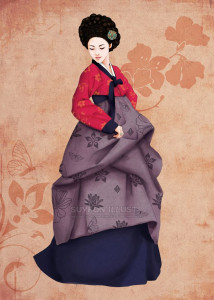
The Korean culture is pushing more influence worldwide, including food, clothes, beauty, and art. Korean art is now more popular with foreigners. People mostly think about traditions in calligraphy, music, or paintings. Korean culture is spontaneously expressed in the use of natural forms, surface decoration, and color, especially in paintings, the form of art that is shaping Korean contemporary art. To mention Korean paintings’ performance, we may not want to forget Hanbok-the Korean traditional clothes representing Korean people’s history and culture.
Table of Contents
A Brief History of Korean Hanbok
Hanbok, also known as Joseonot, is the name of Korean traditional clothes. It is said to date back to the Three Kingdoms period but was only famous worldwide, starting with the Chosun Dynasty. It has marked its beauty throughout history through its regal elegance, moral grace, and harmony with nature. The attractiveness of Hanbok not only comes from the hidden charm through the design lines but also from the unique sophistication of the colors and decorative patterns.
The Art of Hanbok
Flowing Lines
Hanbok emerges the unique beauty of its flowing lines. This beauty distinguishes it from other East Asian traditional clothing, such as Chinese cheongsam, Japanese kimono, or Vietnamese ao dai. Hanbok is a combination of straight and curving lines, which helps the outfit to create a subtle and harmonious look. The collar of women’s Hanbok, which forms a V-shape, can adjust to accentuate or subdue the neckline. Hanbok’s rounded curve of the sleeve’s in-seams brings out a sense of gentleness. It is straight-line projected from the hanging goreum. The coat string-like long ribbon that ties the jeogori closed presents a simple but elegant look. The layers of wrinkles gradually spread out from the waistline to the bottom add to the subdued elegance.
Material
The upper class would wear Hanbok of good quality hemp woven or light fabric. People usually wear Hanbok made from ordinary cotton. But the popular materials today are hemp, cotton, muslin, silk, and satin. Korean women love wearing a Hanbok made of silk in the fall because when moving, it causes a rustling sound like footsteps on dry leaves.
The Beauty of Color
The traditional Hanbok colors are designed based on Yin and Yang’s Five Elements theory to emphasize natural dyes’ harmony. Perhaps because of that, the appreciation of Hanbok not only comes from its shape but also its elegant, sophisticated color and the ultimate ability to coordinate colors. Whether it is a deep color, a warm color, or a bright color gamut, you can always see the harmony in the color combination between the outfit parts.
The Meaning of Hanbok
In ancient times, Hanbok was a way to distinguish classes in society. The nobility would wear one made of silk fabric. And because people sewed it with many layers, the aristocratic Hanbok had a spread and a more solemn feeling. Lower-class people often wear one with simple colors and patterns made of cotton and ordinary ramie.
The widely sewn Hanbok represents the open-minded personality of the Korean people. Some other conceptions also believe that clothing extensively symbolizes fullness. Korean people even pay attention to choosing Hanbok colors and decorations because every detail that appears on it has a specific meaning. For example, selecting a peony pattern symbolizes longevity, choosing the fire pattern symbolizes wisdom, and choosing white tells purity and integrity.
Beauty and Practically
Hanbok seems like an attire that is hard to wear every day because they have many layouts. However, this Korean traditional clothing maximizes practicality and comfortability. It allows easy mobility and movement in daily life. The reason may come from the designers and tailors, who sew Hanbok in a curved fashion following the human body’s general shape. Because its silhouette and flowing lines do not directly tie to the wearer’s physique, people of any body type can wear it without reducing individual dignity or elegance. Simple changes in the color arrangement will allow people to create many looks with different emotional tones.
There have been growing efforts to modernize Hanbok so that people can wear it as daily clothes. One person who is leading in modernizing it is Lee Gi-Yeon. She has her brand, “Jil Kyung Yee”. Since the 1980s, she has started leading research and production efforts to turn them into everyday clothes. Lee achieves the adaptation by looking to the past to bring out the ancestors’ spirit and philosophy into a modern light. The “modernization” of her hanbok collection comes from adapting the clothes with consideration for increased mobility and the human anatomy’s blood circulation patterns. Lee used to answer in a TV interview that “we embed our culture into our clothes.”
To read more about the traditional Korean clothing, you can read this article we’ve written about it!
If you are interested in more Korean fashion, watch the video below!













